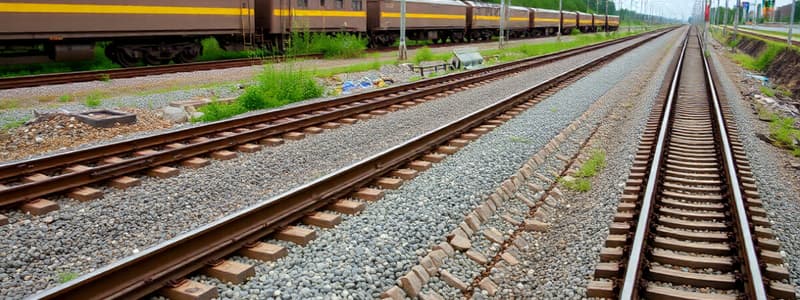Podcast
Questions and Answers
What is the purpose of coning of wheels in railway transportation?
What is the purpose of coning of wheels in railway transportation?
- To enhance the aesthetic appeal of the train wheels
- To facilitate easier maintenance of the rail track
- To improve the stability and guidance of the train on the tracks (correct)
- To reduce the weight of the rolling stock
Which factor is most important in determining sleeper density in railway tracks?
Which factor is most important in determining sleeper density in railway tracks?
- The type of rolling stock used
- The weather conditions throughout the year
- The geographical terrain being traversed
- The speed at which trains operate (correct)
What does the term 'permanent way' refer to in railway systems?
What does the term 'permanent way' refer to in railway systems?
- The dynamic systems used for controlling train movement
- The maintenance schedule for railway tracks
- The temporary structures used for train loading
- The track, including rails and sleepers, that is laid for trains (correct)
What is the significance of using different rail types in railway construction?
What is the significance of using different rail types in railway construction?
In railway track design, what is typically considered when implementing left and right hand turnouts?
In railway track design, what is typically considered when implementing left and right hand turnouts?
Flashcards are hidden until you start studying
Study Notes
Railway Transportation
- A mode of transportation that uses trains running on tracks.
- Provides a cost-effective way to transport goods and people over long distances.
- Typically more energy-efficient than road transport, especially for large volumes.
Track Sections
- The specific arrangement of rails, sleepers, ballast, and other components that make up the railway track.
- Different sections are used for different purposes, such as curves, switches, and straight lines.
- Key components:
- Rails: Provide the running surface for the train wheels.
- Sleepers: Support the rails and transfer load to the ballast.
- Ballast: Provides drainage and stability for the track.
Embankment & Cutting
- Embankment: A raised platform of earth, rock, or other material that supports the track in areas with low ground.
- Cutting: A depression in the ground created by excavation to bring the track below ground level.
- Purpose: To create a level track surface suitable for train operation in varied terrain.
Points and Crossing
- Points: Also known as switches, allow trains to move from one track to another.
- Crossing: A section of track where two or more tracks intersect.
- Used for routing trains and accommodating different traffic flows.
Left & Right Hand Turnouts
- Left-hand turnout: Points are arranged so that trains turning onto the branch track diverge to the left.
- Right-hand turnout: Points are arranged so that trains turning onto the branch track diverge to the right.
- Important for controlling train movement and ensuring safe transitions.
Objects
- Permanent way: The entire infrastructure of a railway track, including rails, sleepers, ballast, and other fixed components.
- Gauges: The distance between the inner faces of the rails, standardized to ensure compatibility between trains and tracks.
- Examples: Standard gauge (1.435 meters), broad gauge (1.676 meters), meter gauge (1 meter).
- Coning of wheels: The slight taper given to the tread of the wheels to help the train stay on track.
- Allows the wheels to self-center on the track, mitigating derailment risk.
- Components of permanent way:
- Rails
- Sleepers
- Ballast
- Track fixtures and fastenings: Provide the means to attach the rails to the sleepers and ensure stability of the track.
- Track drainage: Removes rainwater and moisture from the track.
Sleeper Density
- The number of sleepers per unit length of track.
- Determines the stiffness and load-carrying capacity of the track.
- Higher density is used for heavy-duty traffic and high-speed trains.
Rail Fixtures & Fastening
- The components that connect the rails to the sleepers, ensuring a secure and stable track.
- Types include:
- Fishplates: Join two rails together.
- Bolts, nuts, and washers: Secure the fishplates and rails.
- Clips: Fasten the rails to sleepers in some systems.
- Spikes: Historically used to fasten rails to wooden sleepers.
Rail Types & Functions
- Different rail types are used for different track conditions and train loads.
- Common rail types:
- Standard rails (R260, R380): Used for most railway lines.
- Heavy rails (R540, R600): Used for high-capacity lines and freight tracks.
- Light rails (R180, R220): Used for light rail and tram systems.
- Functions:
- Provide a smooth and durable surface for train wheels.
- Transfer load to the sleepers and ballast.
- Guide the train along the track.
Studying That Suits You
Use AI to generate personalized quizzes and flashcards to suit your learning preferences.




